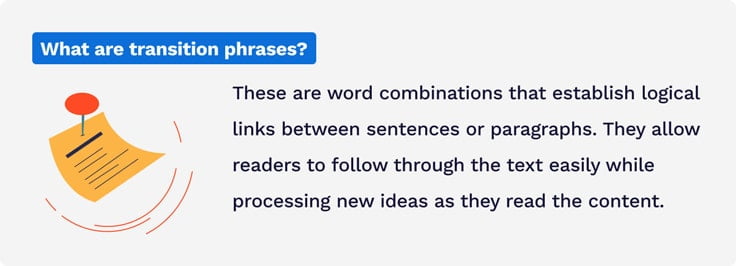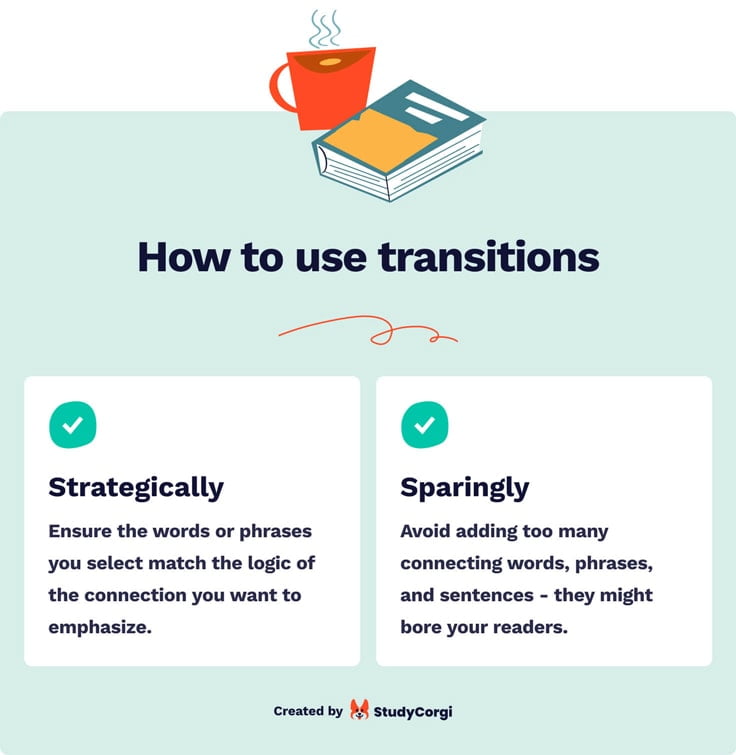📝 Transition Phrase Maker – How to Use It?
Looking for an effective way to highlight transitions in your content? Try our transition phrase generator and get the best results effortlessly.
Our tool is simple and free for writers and students who want to generate relevant transitions to include in their content or college essays.
Get random transition phrases and improve your writing process seamlessly:
- Choose what you need the tool to do: add transition phrases to your essay or show suitable transition phrase examples.
- Add the necessary data: paste your paragraph or choose what transition phrase ideas you need to see.
- Push the button and get your result.
👌 The Benefits of This Transition Phrase Generator
Our online transition phrase generator has many benefits.
It is:
| 💸 Free | This tool is accessible to users at no cost. You don’t have to pay any penny to access, use, and download the list of phrases. |
|---|---|
| 🎵 Tunable | You can select any type and purpose of transition phrases easily. |
| 🔀 Flexible | The generator lets you get a list of phrases you need or add them directly to your text. |
| 🦄 Intuitive | This transition maker is intuitive, and you can easily use it with the prompts on the interface. |
| 🚀 Fast | You can get immediate results within a few seconds of using this transitional phrase generator. |
🎓 Transition Phrases in Academic Writing
In academic writing, your primary goal is to communicate information clearly and concisely. It is imperative to present your arguments objectively to avoid swaying the reader to your perspective.
Thus:
Using transition phrases is vital in helping you attain this goal.

What are transition phrases, and what do they do?
These word combinations establish logical links between sentences or paragraphs, indicating the relationships between the sections of your academic paper.
In other words:
Transitions function as indicators that allow readers to follow the writer’s thoughts easily while processing new ideas as they read the content.
They can appear as:
- Words,
- Short phrases,
- Full sentences.
Transitions offer the readers the right direction on how they can connect the ideas from your paper’s introduction, body, and conclusion logically. These words have specific meanings that make the readers think a certain way about your content, which works especially well in persuasive writing.
So:
By giving the audience these essential signs, the transitions assist the readers in comprehending how your ideas relate together.
How to Use Transition Phrases
In this section, we explain how to use transition phrases in academic writing so that they will work effectively.

Here are ways you can use transition phrases:
- Strategically. You must use the transitions strategically by ensuring the words or phrases you select match the logic of the connection you want to emphasize. It is imperative to understand the usage and meaning of each transition word or phrase you want to use in your paper. Keep in mind that the transitions must align with the paper’s logic.
- Sparingly. Another way is to use transitions sparingly to avoid adding too many connecting words. You might bore your readers with numerous transitions in a paper with clear information.
✍️ Transitional Phrases: Types & Examples
As mentioned above, it is important to understand the meanings of transition words before using them in your paper.
There are different types of transition phrases, and each category has more precise functions.
Additive Transition Phrases
Additive transitions are words or phrases used when introducing examples or new information. These phrases are usually used to compare with, expand upon, or explain a previous text more clearly.
Examples of additive transition phrases are as follows:
- In a similar way,
- In the same way,
- By the same token.
An example sentence with additive transitions is:
Adversative Transition Phrases
Adversative transitions are used as indicators to present arguments, establish facts, or add information that contrasts the previous text. You can use adversative phrases to concede points or present counterarguments in your paper.
Other functions of these transitions include:
- Replacement (at least, if not),
- Emphasis (most importantly, above all),
- Dismissal (regardless, either way),
- Concession (even so).
Examples of these transitional phrases are as follows:
- On the other hand,
- In contrast,
- On the contrary.
Here’s an illustration of adversarial transitions in context:
Causal Transition Phrases
Casual transition phrases indicate the purposes, conditions, reasons or cause-and-effect relations. You can place these phrases after important points have already been presented in the paper or when you need to explain hypothetical connections or circumstances.
Examples of casual transition phrases are as follows:
- As a result,
- As a consequence,
- For this reason.
We can illustrate the use of causal transitions this way:
Sequential Transition Phrases
Sequential transitions are phrases that show a particular sequence of events. They reveal a continuation of thoughts, indicate deviations, and summarize or conclude information.
Examples of sequential transition phrases are:
- First of all,
- To start with,
- In the second place.
Example sentence:
Thank you for reading this article! If you want to work with transitional words and sentences, check the tools we’ve developed:
❓ Transitional Phrase Generator FAQ
❓ What is a transition phrase?
A transition phrase, also known as a linking or connecting word, is used to connect different ideas together in a text. Transition phrases help readers to understand the content and follow arguments since they express the connections between various sentences.
❓ What is the purpose of using transition words and phrases in essays?
Transition words and phrases are used to link ideas and sentences to ensure logical content flow. The main purpose of these phrases is to indicate the connections between sentences and paragraphs.
❓ What is an example of a transitional phrase?
An example of a transitional phrase is “for instance,” which functions as an additive transition. This phrase introduces new examples or information to explain a previous text.
❓ What is a conclusion transition phrase?
A conclusion transition phrase is usually used in the conclusion section of an article or academic paper. It is used to tie the ideas presented in the paper as one and present a conclusive statement. Examples are “in conclusion,” “to conclude,” and “to sum it all up.”